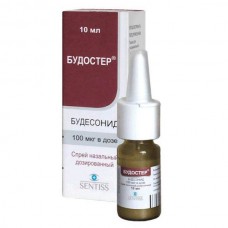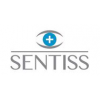Expiration date: 09/2026
Pharmacological action
Budoster - corticosteroids for intranasal use. Has a pronounced anti-inflammatory and antiallergic action. When used in therapeutic doses, has practically no resorptive action. Has no mineralocorticoid activity, is well tolerated for prolonged use. The drug has an inhibitory effect on the release of mediators of the inflammatory response, reduces the number of fat cells and eosinophilic granulocytes. Budesonide reduces the release of toxic proteins from eosinophils, free radicals from macrophages and lymphokines from lymphocytes. It also reduces the binding of adhesion molecules with endothelial cells, thus reducing the influx of leukocytes to the site of allergic inflammation. Budesonide increases the number of ?-adrenergic receptors of smooth muscles. The drug inhibits the activity of phospholipase 2A, which leads to inhibition of the synthesis of prostaglandins, leukotrienes and complete fre und's adjuvant (PAF),inducing the inflammatory response. Budesonide also inhibits the synthesis of histamine, which leads to decrease in its level in fat cells.
Budesonide reduces the severity of symptoms in allergic rhinitis, suppresses the early and late phase allergic reactions and reduces inflammation in the upper respiratory tract. The therapeutic effect develops after an average of 5-7 days.
Pharmacokinetics
Suction
After inhalation of budesonide 400 ág Cmax in plasma is reached within 0.7 h and is 1 nmol/l. Only about 20% of the intranasally administered dose reaches the systemic circulation.
Distribution
Due to its good tissue distribution and plasma protein binding, apparent Vd is 301 L.
Metabolism
Systemic bioavailability of budesonide is low, since more than 90% absorbirowawrzayasa of the drug is inactivated in the single-stage process of metabolism in the liver. The GCS activity of the metabolites does not exceed 1%.
Excretion
T1/2 - 2-2.8 h. Excreted via the gut in the form of metabolites and 10%, the kidneys - 70%. The concentration of budesonide in plasma is increased in patients with liver disease.
Testimony
- prevention and treatment of seasonal and perennial allergic rhinitis;
- vasomotor rhinitis;
- polyps of the nose.
Contraindications
- fungal, bacterial and viral infections of the respiratory tract;
- the active form of tuberculosis of the lungs;
- vozrasta children up to 6 years;
- hypersensitivity to budesonide or any component of the drug.
With caution: a recent surgical intervention in the nose, recent nose injury, tuberculosis.
Application of pregnancy and breastfeeding
The use of the drug Budoster during pregnancy may take place only if the expected benefit to the mother outweighs the potential risk to the fetus. If necessary, the appointment of the drug during lactation breastfeeding should be discontinued.
Special instructions
Do not use budesonide nasal spray in patients with respiratory tract infections.
Patients should be informed that the effect of the use of the nasal spray of budesonide is achieved after an average of 5-7 days.
If after three months of treatment the symptoms do not decrease, the drug should be discontinued.
When moving from treatment of systemic corticosteroids in corticosteroids for topical application there is a risk of adrenal insufficiency, therefore, requires caution in the period when the function of the hypothalamic-gioviano-adrenal system. Cancel the drug should be by gradual reduction of the dose to normalize the function of the hypothalamic-pituitary-adrenal axis. At the stage of dose reduction in some patients there may be withdrawal symptoms of corticosteroids such as pain in muscles and/or joints, lethargy, depression. In identifying such symptoms may require a temporary increase in dose systemic corticosteroids and subsequently further cancellation at a slower pace.
To achieve a therapeutic effect in allergic rhinitis requires a regular administration of the drug.
It is recommended to monitor the growth of children receiving prolonged treatment with nasal corticosteroids. The growth rate of the child slows, dose of nasal spray should be reduced.
Because corticosteroids slow wound healing, care should be taken when administering the drug Budoster patients who recently had an injury or surgery in the nose area.
You should avoid getting the nasal spray budesonide in the eye.
Long-term drug therapy is necessary to assess the condition of the mucous membrane of the nose.
Prolonged use of corticosteroids for nasal use in children recommended dynamic control growth. At slowing the growth of the pediatrician should review method of application of the drug, to reduce the dose and of transition to the minimum therapeutic dose, where a possible control of symptoms.
Effects on ability to drive vehicles and management mechanisms
Budoster has no effect on the ability to drive or mechanisms.
Composition
1 dose contains:
active substance: budesonide 100 mcg
excipients: dextrose, avicel (cellulose microcrystalline and carmellose sodium in the ratio 9:1), potassium sorbate, Polysorbate 80, disodium edetate, hydrochloric acid to pH 4.5, purified water.
Method of application and doses
Adults and children over 6 years old at the beginning of therapy in 100 micrograms in each nostril 2 times/day. The usual maintenance dose is 50 mcg in each nostril 2 times/day or 100 micrograms in each nostril 1 time daily in the morning. The maintenance dose should be the lowest effective dose to eliminate symptoms of rhinitis. The maximum single dose is 200 mcg (100 mcg in each nostril), the maximum daily vine is 400 mcg for no more than 3 months.
For full therapeutic effect of the drug Budoster requires regular and proper use.
If the reception of the vines was omitted, it should be taken as soon as possible but not less than 1 hour before the next dose.
Children use the drug under the guidance of adults.
Side effects
Local reactions: burning sensation; crusting on the nasal mucosa, dizziness. You should consider the risk of systemic effects, including the inhibition of adrenal function, growth retardation in children and adolescents, decrease in bone mineral density, symptoms of hyperadrenocorticism. cataracts and glaucoma with the use of budesonide in the high vines. Very often, irritation of the mucous membrane of the cavity of the claim. At the beginning of therapy, for a short time, you may experience runny nose, excoriation. Often sneezing; sore and dry throat, pain in nose and throat. Rare - nasal bleeding; candidiasis of the mucous membrane of the pharynx and the nasal cavity, especially after prolonged therapy. Very rarely atrophy of the mucosa, ulceration of the mucous membrane of the nasal cavity, perforation of the nasal septum; anosmia.
Allergic reactions: rarely - allergic reactions (including dermatitis, rash, urticaria).
From the digestive system: rarely - nausea, vomiting, gastralgia.
From the side of cardiovascular system: very rarely - palpitations.
From the nervous system: rarely - myalgia, drowsiness, and headache.
The respiratory system: rarely - cough, nasal congestion.
Drug interactions
Phenytoin, phenobarbital, rifampicin may reduce the effectiveness, methandienone, estrogens, ketoconazole and other strong inhibitors of isoenzyme ?????4 - to increase.
Overdose
Symptoms (in chronic overdose): acne, Cushing's syndrome, dysmenorrhea.
Treatment: gradual withdrawal of the drug.


